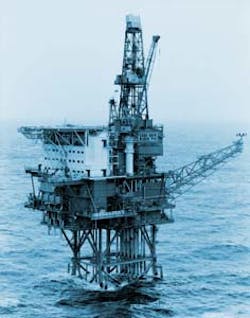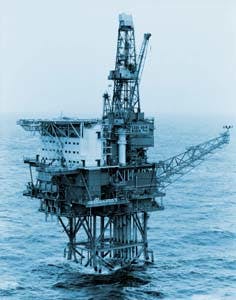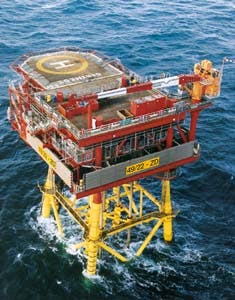NAM kicks off development of East-of-Nogat blocks
Feico Houweling
Contributing Editor - Rotterdam
The wellhead jacket during load-out at HSM's yard: the access deck was welded to this on the load-out barge.
The skirt pile sleeves. (Photos courtesy Iv-Marcon Engineering).Development of one of the last untouched areas on the Dutch continental shelf is under way through what will be the largest processing platform in the sector.
Operator NAM awarded the first contract for the L9 gas project in 1995. The block is situated east of the Nogat pipeline and north of the Wadden Zee. Once the main platform comes onstream in June next year, NAM expects spare slots to allow fields in the area to deliver supplies for several decades.
The first phase of L9 comprised the conceptual design and work scope for the wellhead platform jacket, as NAM intended to drill and complete the production wells prior to installing the topsides in 1998. The conceptual design was based on a conventional jacket with piling through the jacket legs, but the fabrication tendering contractors requested Iv-Marcon to work out their alternative option using skirt piles. When the construction contract for the L9 wellhead structure was awarded to HSM in March 1996, the operator had selected the skirt pile version.
Use of skirt piles allowed NAM to decrease offshore installation costs compared with a jacket with a separate access deck. The deck enhances safety during drilling and installation of the conductors. Following installation of the topsides the access deck will function as a cellar deck.
Among the features of the wellhead substructure are the relatively large number of conductor slots - 12 - and the long lifetime design of 40 years. As NAM demanded an inspection-free substructure, it was decided that the fatigue design of the jacket had to exceed the normally expected lifespan by at least four times.
Using skirt piles instead of piles through the jacket legs also allowed the designers to minimize the jacket leg diameter and thus the impact of wave forces on the structure. As the skirts had the effect of widening the basis of the jacket, the required piling depth could also be shortened.
Central platform
As for the central L9-FF production platform, the approved-for-construction package was delivered to NAM early this year by the Schiedam office of Stork Engineers & Contractors (SE&C). Construction of this platform's jacket, the wellhead platform topsides and the 45 meter connecting bridge has now started at Grootint in Zwijndrecht. The structures should be installed in spring 1998, with field start-up the following June.SE&C also designed the 20 km, 24-in. evacuation pipeline which will connect the platform with the Nogat trunkline. The gas treatment process will be similar to NAM's L15-FA-1 platform which was designed by Stork Protech in the early '90s. Production capacity of the L9-FF-01 will be 16 MMcf/d. There are no other single production installations on the Dutch shelf with comparable capacity.
"We expect that a number of satellites or subsea completions will be installed around the L9-FF-01 platform in order to increase the amount of gas produced from the area," says Cees de Hoon, project manager with SE&C. The platform was therefore designed for a total lifetime of 40 years. "It will function as a central processing installation for the entire area." Space for adding risers to the platform in future has been included in the design.
The Nogat plant in Den Helder will have to be extended to handle extra capacity of 12 MMcm/d. This work was awarded to the Amsterdam office of SE&C, formerly Stork Comprimo until its merger this January with Stork Protech.
Total weight of the production platform will be 4,640 tons. The structure will consist of three modules. "We delivered the specifications for the accommodation module in such a way that it can be built separately by a specialized contractor," explains de Hoon. Here the builder has yet to be selected, but the utilities and control module, designed in detail by SE&C, will be built by Grootint and most likely integrated into the platform. The third module will contain the gas treatment installations and will offer space for a future compression module.
L9-FF's production platform topsides will measure 30x50 meters at the base, with a 44 meters high helideck. The six-legged jacket will weigh 2,000 tons, including the piles. The wellhead platform topsides measures 20x22 meters at the base with a non-operational weight of 600 tons. Its recently installed jacket, with piles, weighs 1,000 tons. Total weight of the installations during operation will be 12,200 tons.
Copyright 1997 Oil & Gas Journal. All Rights Reserved.


